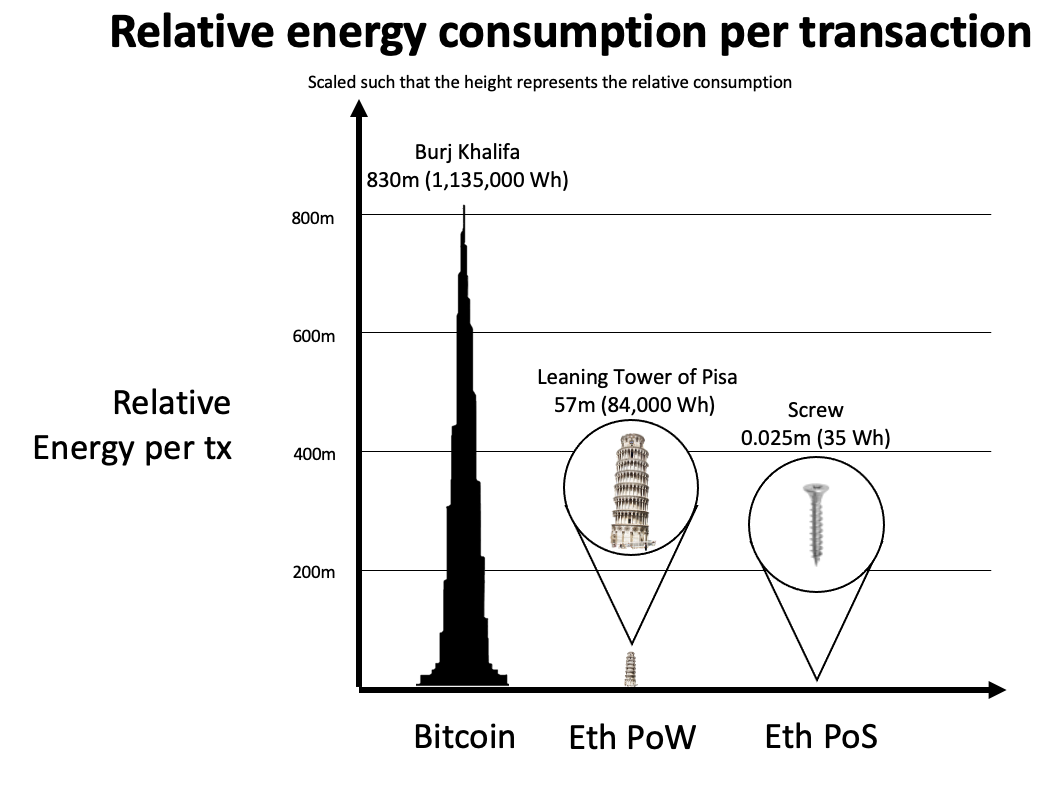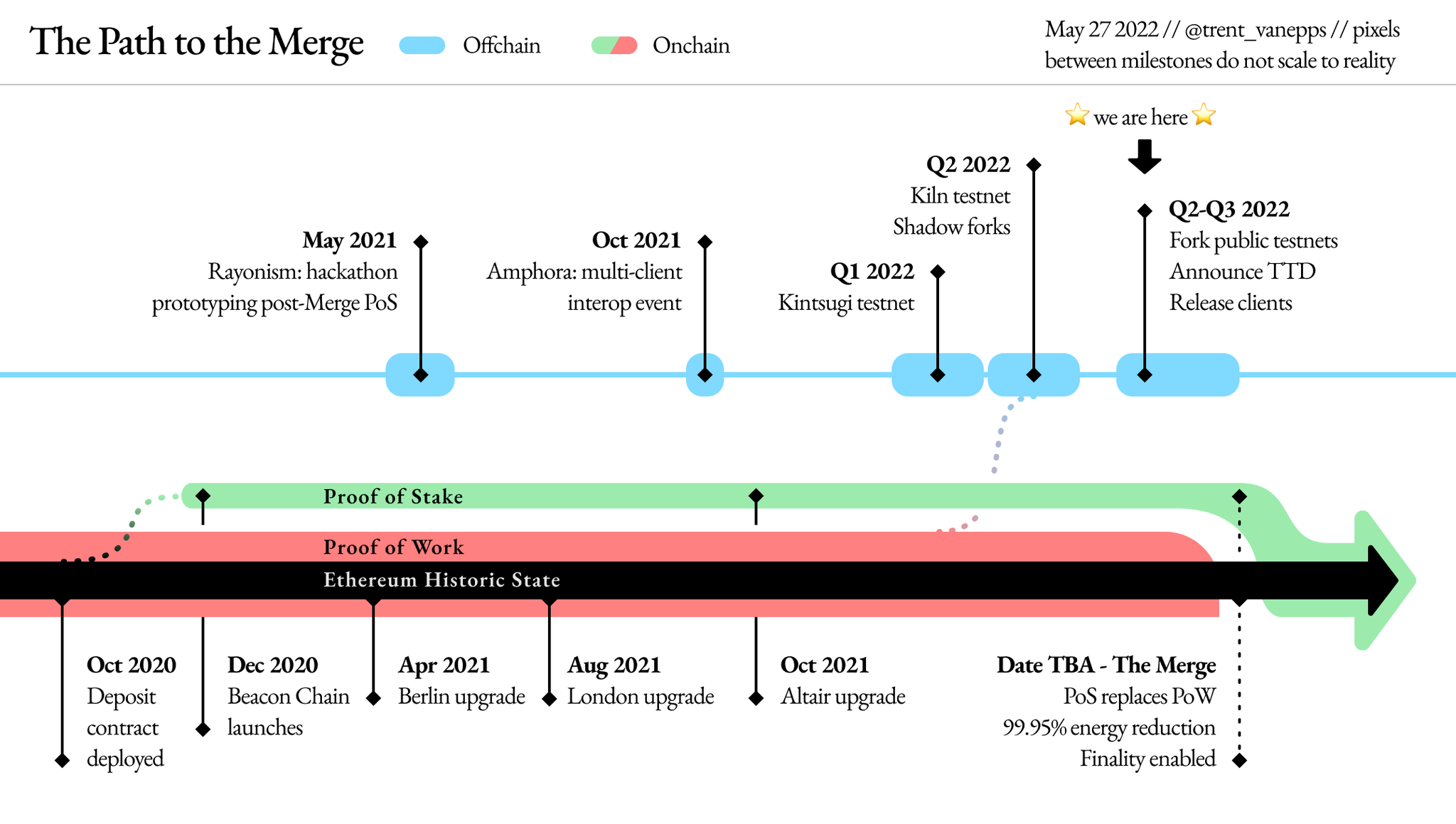After years of delays, the most anticipated upgrade in Ethereum’s history is set to take place on or around 15 September 2022.
Known as the Merge, Ethereum will move from a Proof of Work (PoW) to a Proof of Stake (PoS) network.
This has big implications: it will make Ethereum more secure, less energy-intensive, and lay the foundation for future upgrades to increase scalability.

If all goes according to plan, it will be an upgrade six years in the making – an eternity in crypto-time.
One of the biggest changes to the new network is energy consumption. Shifting from PoW to PoS would reduce energy consumption by a projected 99.95%.
To put it into perspective, if Bitcoin’s energy consumption was as tall as the Burj Khalifa, a Ethereum PoS network would be the height of a screw.

This article was submitted by a Guest Contributor. The opinions expressed in this publication are those of the Guest Contributor.
What will happen during the Merge?
Even by crypto standards, the Merge is an incredibly complicated process. One critic opposing the Merge described it as “flying the jet, and changing the engine in the sky”.

To ensure the Merge goes as smoothly as possible, Ethereum developers have conducted a series of dress rehearsals to prepare for the actual day. For the past two years developers have been testing this new PoS network on testnets – an alternative blockchain testing environment – to work out any major bugs and issues.
On 10 August 2022, Ethereum completed the Goerli public testnet merge — its final trial before making the shift on the mainnet. (This is also why the change is called “the Merge”, because the already running testnet will merge with the existing Ethereum chain.)
Why the shift from Proof of Work to Proof of Stake?
Proof of Work and Proof of Stake are two forms of consensus mechanisms. This is arguably the most critical component of a blockchain network. It is the mechanism used to validate transactions on the blockchain. It also rewards good behaviour (participants receive cryptocurrency for validating transactions) and disincentivises bad behaviour.
We won’t go into the intricate differences between PoW and PoS consensus mechanism, but this report by the crypto exchange Kraken is worth a read if you’re looking for a deep dive.
The Tl;dr: PoW requires miners to compete to solve a cryptographic puzzle. This energy-intensive process consumes huge amounts of electricity. The winner gets to verify all the transactions in a block, in doing so collecting a reward, such as bitcoin.
In contrast, PoS is secured by validators instead of miners. Validators need to lock up (i.e. stake) their coins to be able to validate new transactions on the network. A PoS will pick a winner in proportion to their staked amount. This is significantly more energy efficient than PoW – as it doesn’t require miners to spend electricity to compete to solve the same puzzle.
BTW – we share commentary on Singapore Investments every week, so do join our Telegram Channel (or Telegram Group), Facebook and Instagram to stay up to date!
We also share great nuggets of wisdom on Twitter.
Don’t forget to sign up for our free weekly newsletter too!
[mc4wp_form id=”173″]
What are the implications of the Merge?
#1 The Merge will NOT lead to lower gas fees
One common misconception is that the Merge will lead to lower transaction (“gas”) fees. The Ethereum Foundation stated on their website that the Merge is a “change in consensus mechanism, not an expansion of network capacity”.
They emphasise this point because Ethereum’s been plagued with scalability challenges in the last few years. High demand has sent gas fees skyward, with some transactions costing as much as $200. It’s one of the biggest pain points for users, and competitor blockchains like Solana directly address this problem to attract users.
The Merge won’t fix that problem immediately, but it paves the way for future upgrades to increase scalability. Several “Layer 2” features are in the works. These are technologies built “on top” of the main Ethereum blockchain.
For example, rollups, as the name suggests, “roll up” a multiple transactions into one to cut down on fees and increase Ethereum’s bandwidth. Meanwhile, sharding splits the Ethereum network into multiple portions to reduce congestion.
#2 Increased participation – at the cost of higher concentration risk?
Mining on a PoW blockchain is an expensive operation. It requires huge upfront investment to purchase specialised hardware and access to cheap electricity.
The transition to PoS removes this barrier. Participants can run a node with consumer-grade laptops and do not need any specialised equipment. By making it easier to contribute to securing the network, it should improve decentralisation by encouraging more people to become nodes.
However, some say PoS will have the opposite effect – Ethereum will become more centralised and less secure. That’s because capital ownership determines network control in a PoS network. In other words, the people with the most money in the network have the most control.
This is compounded by the fact that many users do not stake their ether directly. Instead they delegate the work to entities like Coinbase and LidoFinance, who hold a huge chunk of staked Ether on behalf of their users. As reported in Fortune, data firm Messari identified that Lido Finance controls 31.2% of all staked Ether, Coinbase controls 14.7% and Kraken 8.5%.
#3 It makes Ethereum more attractive to investors
Ethereum’s massive reduction in energy usage will eliminate concerns about the cryptocurrency’s environmental-friendliness. More climate-conscious individuals might be more inclined to buy into a cryptocurrency that’s in line with their values.
Many institutional investors are also bound by ESG mandates, which forces them to sit on the sidelines when it comes to projects with a negative climate impact. With the Merge, institutional investors, such as endowments, family offices and pension funds might be able to invest in ether.
Conclusion
The Merge is by far one of the biggest events in the crypto world to date. If it goes smoothly, it will be one bright spot in a terrible year for crypto.
However, even with the rigorous testing, there’s always a risk of something going wrong. This would be catastrophic for the thousands of apps built on Ethereum, which collectively handle more than $50 billion in user funds.
This article was submitted by a Guest Contributor. The opinions expressed in this publication are those of the Guest Contributor.